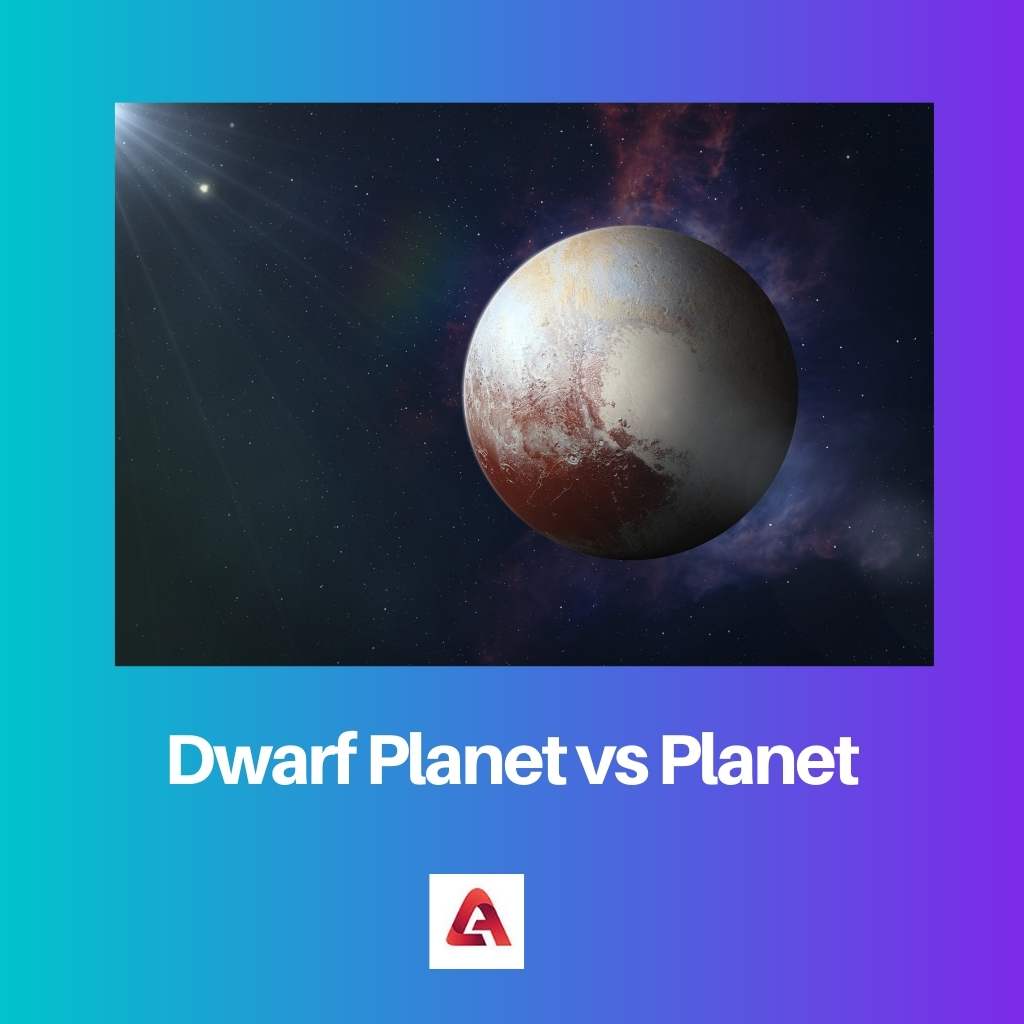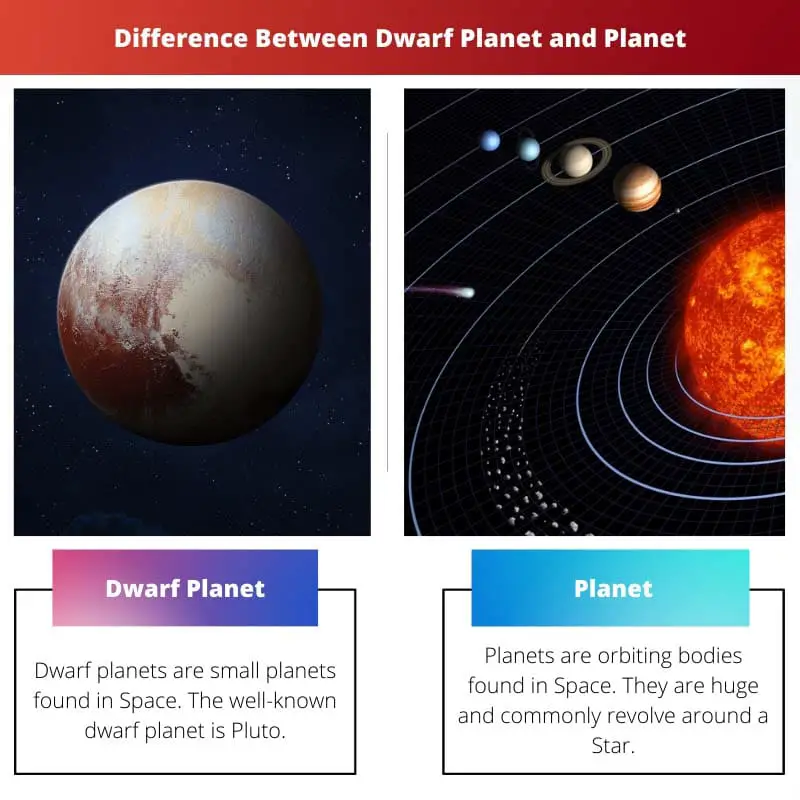Planets are celestial bodies orbiting a star in space. They are huge and have their gravitational force. Sun is orbited by eight planets. Some planets can be seen with the naked eye from Earth.
Our Earth is one of the eight planets in the Solar system. Planets have been linked to deities and spirituality in many cultures. They are also considered to cause crucial changes in astronomy.
Key Takeaways
- A planet is a celestial body orbiting a star, massive enough to have cleared its orbit of debris and maintain a stable, nearly spherical shape.
- A dwarf planet shares some characteristics with planets but lacks the gravitational force to clear its orbit, resulting in co-orbital objects.
- Both celestial bodies contribute to our understanding of the solar system but differ in size, orbit-clearing capability, and classification.
Dwarf Planet vs Planet
Planets are celestial bodies that orbit a star, such as our sun, and are large enough to have sufficient gravity to form a nearly spherical shape. Dwarf planets are celestial bodies that orbit a star and have a nearly spherical shape but have not cleared their orbit of other debris.

Dwarf planets are small planets found in Space. The well-known dwarf planet is Pluto. A scientist named Alan Stern coined the term Dwarf Planet.
He termed this name to classify the celestial bodies into three categories: Planets, Dwarf Planets, and Satellite Planets. The first Dwarf planet discovered was Ceres.
It was discovered in 1801. Scientists believed that it was a planet at that time, but later it was designated as a Dwarf Planet.
Planets are orbiting bodies found in Space. They are huge and commonly revolve around a Star. Planets have been linked to various myths and religious views.
They are considered the emissaries of deities by some people. But science and technology have given us a clear perspective of these celestial bodies. With the advancement of space science, the way humans perceive the Planets has changed.
Comparison Table
| Parameters of Comparison | Dwarf Planet | Planet |
|---|---|---|
| Diameter and Mass | Mass and diameter of Dwarf planets are small | Planets have a greater mass and diameter but these parameters differ from one planet to another |
| The Largest member | Pluto is the largest Dwarf planet | Jupiter |
| The Smallest member | Hygiea is considered the possible smallest one | Mercury is still cooling down and thus decreasing in size. This makes it the smallest. |
| Gravity | Dwarf planets are smaller in size and do not have a gravitational influence | Planets gravitationally influence the neighboring bodies attracting them towards it. |
| Orbit | Dwarf planets do not have a clear orbit | Planet have a clear orbit |
What is a Dwarf Planet?
As the name indicates, Dwarf planets are small planets in Space. They are not as large as Planets. The first dwarf planet was identified in 1801.
It was named Ceres. Astronomers considered it as a Planet. After a few years, they stopped calling Ceres and other bodies like its asteroids as Planet.
But when Pluto was discovered in 1930, it was also considered a Planet. Pluto’s moon was discovered in 1978, which helped to calculate the mass of Pluto.
By calculating the mass, it was found out that Pluto was much smaller than the smallest planet in the Solar system. Various other characteristics were also considered to remove Pluto from the classification of Planets.
Dwarf planets cannot dominate the neighbouring celestial bodies. Though they have a huge mass, they do not possess the ability to clear the neighbourhood.
Since the primary character which makes a Planet is gravitational dominance, bodies like Pluto and Ceres cannot be considered as Planets. NASA has stated that there may be hundreds of dwarf planets that need to be discovered.
Ceres, Pluto, Eris, Makemake, and Haumea are some of the well-known dwarf planets discovered. Dwarf planets remain a debatable topic, and there are still many controversies and myths going around about the Dwarf planets.

What is a Planet?
Plants are large bodies made up of rock and gases. They are believed to be formed from an entity of gas and dust. Planets orbit around the Sun. But during ancient times, it was considered that the Planets orbit around the Earth.
Only after the invention of the telescope by Galileo Galilei it was confirmed that Sun is what the Planets orbit around. Since then, various efforts have been made to find new facts about these Planets. Some of the planets can be seen from Earth.
Just like our Earth, other planets also experience hurricanes, Tectonic movements, Volcanoes, and some planets have shown hydrology. Studies on planets are being conducted by different organizations working in different countries.
NASA is the most known and renowned centre for space science. These organizations send spacecraft to the target planets and run tests on their soil and atmosphere with the help of Robots.
There are thousands of planets in the milky way galaxy. Since those planets are not a part of our Solar system, they are known as extrasolar planets. There are 4878 extrasolar planets in the galaxy.
When Roman astrologers studied the planets and astronomy, they gave planets the names of their Gods.
Planets rotate on their axis while orbiting the Sun. Each planet has many natural satellites rotating them.
Mercury doesn’t have an atmosphere. It is present next to the Sun, and so even if it has an atmosphere, it will be hotter, and the molecules may speed up and move out of the atmosphere.
Earth has a unique atmosphere. Earth is the only known planet supporting life. Oxygen is not found on other planets but on Earth.

Main Differences Between Dwarf Planet and Planet
- Dwarf planets are smaller compared to Planets in the Solar system, but Planets are large in mass and diameter.
- Only a few dwarf planets have been discovered, while a huge number of Planets have been discovered and named.
- Dwarf planets cannot dominate the neighbourhood, but Planets can gravitationally dominate their neighbourhood.
- Dwarf planets have many other bodies in their orbital. In contrast, the orbital of Planets is clear and has no other celestial bodies like asteroids. This is because of the gravitational dominance ability that planets clear their orbital.
- Dwarf planets need more attention because only a few missions have been established to research them. But, Planets have been studied well over the past century, and much information about their topography and chemical nature is known.

- https://iopscience.iop.org/article/10.1088/1674-4527/21/6/133/meta
- https://science.sciencemag.org/content/316/5831/1585.abstract

While the distinction between dwarf planets and regular planets is clearly outlined, the controversies and debates surrounding dwarf planets are intriguing. The article effectively captures the dynamic nature of astronomical concepts and fosters curiosity about ongoing research in the field.
The article’s factual accuracy and focus on scientific data are commendable. It successfully dispels common myths and presents a clear understanding of the topic. The references provided at the end add credibility to the information presented.
The exploration of the history and cultural significance of planets in various societies offers a well-rounded perspective. It acknowledges the broader impact of celestial bodies on human civilizations, seamlessly integrating scientific and historical elements for a compelling narrative.
Although the article presents relevant information on planets and dwarf planets, it might benefit from a more engaging writing style to captivate a broader audience. The content is rich in details, but the delivery could be made more compelling to evoke greater interest in the subject.
This systematic comparison of dwarf planets and regular planets enhances our understanding of these celestial bodies. The comprehensive analysis is thoughtfully structured, addressing key differences while maintaining a scholarly tone. A thorough and illuminating piece.
This article provides extensive information on the topic. The differences between a dwarf planet and a regular one are very clearly specified, making it easy to understand the distinction between them. It’s fascinating to read about such celestial bodies with scientific and historical perspectives.
Indeed! The in-depth analysis offers valuable insights into the complex world of astronomy. I’m impressed by the comprehensive comparison table that highlights the contrasting features of dwarf planets and planets. Highly informative read.